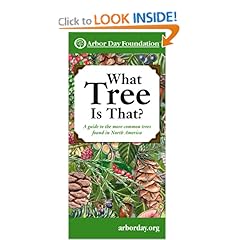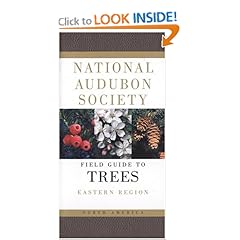 Mostly this blog has been about climate policy. I admit to not being much of a dyed-in-the-wool environmentalist ... until recently, that is. Now all that is changing. I'm actively trying to cultivate the tree-hugger in me these days.
Mostly this blog has been about climate policy. I admit to not being much of a dyed-in-the-wool environmentalist ... until recently, that is. Now all that is changing. I'm actively trying to cultivate the tree-hugger in me these days.When I hug a tree, though, I'd like to know its name.
Regretfully, I am pretty clueless about knowing how to look at a tree and tell you either its common name or its scientific appellation. So I got a book to help. It's by the Arbor Day Foundation, and it's called What Tree Is That?
This "guide to the more common trees found in North America" is turning me into a savant of silviculture. Yesterday I took it to a nearby arboretum — actually, a tree-labeled stretch of the walking path around Wilde Lake in Columbia, Maryland — in order to see whether it would guide me to the same tree designations as are posted on the signs in front of the trees. It did!
 My biggest triumph had leaves like the one at right — a stalk with several leaflets — depicted above a seedpod, which I will talk more about anon.
My biggest triumph had leaves like the one at right — a stalk with several leaflets — depicted above a seedpod, which I will talk more about anon.You have to play a game to identify a tree.
First — after you turn to the proper section of the book, for either the Eastern U.S. or the Western U.S. — you are asked to answer whether the tree has needles, or scale-like leaves that hug the twig, or leaves that are flat and thin. The first two are types of conifer or evergreen, while the latter represents broadleaf, deciduous trees. I chose the latter, and was directed to the next question.
It asked me to distinguish between trees whose leaves have just one single blade attached to each stalk or petiole, in which case the leaf is simple; more than one blade per petiole, in which case the leaf is compound; or fan-shaped leaves multiply attached to short, spur-like branches, in which case the tree is a ginkgo. I chose option two.
The next question wanted me to say whether the compound leaves were opposite or alternate. If the former, each pair of blades or leaflets on either side of the stalk or axis (except for the end leaflet, that is) attach to the stalk at the same exact point. If the latter, unpaired leaflets appear on alternate sides of the stalk. My quarry's compound leaves were of the alternate variety.
 The next question was, in effect, did the leaflets themselves have leaflets? If so, the leaf would be not just pinnately compound, but twice pinnately compound, a.k.a. bipinnate. At left, we see both options, though in compound leaves that are opposite, not alternate.
The next question was, in effect, did the leaflets themselves have leaflets? If so, the leaf would be not just pinnately compound, but twice pinnately compound, a.k.a. bipinnate. At left, we see both options, though in compound leaves that are opposite, not alternate. (I seem to not have needed to answer whether my tree's compound leaves were palmate, as in the image at right, meaning that leaflets are arranged to form an outline like the palm of a hand with fingers splayed apart.)
(I seem to not have needed to answer whether my tree's compound leaves were palmate, as in the image at right, meaning that leaflets are arranged to form an outline like the palm of a hand with fingers splayed apart.)My leaves were just pinnately compound.
Next, were the side buds (which, I imagine, are the places where new twigs can emerge from existing twigs) hidden by the leaf base, or exposed? If hidden, that would mean the tree's fruit (none of which was actually in evidence) was a pod or legume. Best I could tell, there were no side buds in evidence.
(Had they been, a quick look ahead in the book told me I was en route to identifying a tree-of-heaven, an American mountain-ash, a European mountain-ash, a black walnut, or a butternut. I decided to press ahead along the no-exposed-buds logic path and come back if it left me high and dry — which, as it turns out, it didn't.)
Per the next question, large, 2-4" blades/leaflets would have ID'ed my tree as a yellowwood ... but I was looking at small leaflets of less than 2" in length.
Next, the book wanted me to say whether the tree's fruit was in a long, brown, leathery pod. I saw no fruit to judge by, but the book also suggested that "native trees" of this same type have "long, branched thorns." I saw no thorns, either, so I took a chance and said the tree was not a honeylocust.
That meant its identity depended on answering just one final question. If the leaflet blades' tips were not angled or pointed, but rounded, the tree would have been a black locust, and presumably its twigs would have borne spines or prickles. But, no, the blades were rounded, and there were no spines or prickles .... which made the tree, supposedly, a Japanese pagodatree.
Say what?
I'd never heard of a Japanese pagodatree. Was I on the wrong continent? It was time to inspect the arboretum's signage for the tree.
Oops!
The sign said it was a Chinese scholartree!
Had I been led down the garden path?
Luckily, I noticed that the Latin name on the sign was Sophora japonica ... and then I noticed that that name was printed in the book below Styphnolobium japonicum, which the book says is the current name of the tree formerly known as Sophora japonica!
The Chinese scholartree and the Japanese pagodatree are the same tree!
And my experience thus far with What Tree Is That? is an unqualified success! Highly recommended.
 What Tree Is That? does not pretend to tell all: all the info, that is, that you might want to find out about the tree you have just ID'ed. For that, I can turn to the National Audubon Society Field Guide to North American Trees (Eastern Region). It is a true field guide to far more tree species — my edition has 364 kinds of trees — than the "more than 250" that What Tree Is That? covers.
What Tree Is That? does not pretend to tell all: all the info, that is, that you might want to find out about the tree you have just ID'ed. For that, I can turn to the National Audubon Society Field Guide to North American Trees (Eastern Region). It is a true field guide to far more tree species — my edition has 364 kinds of trees — than the "more than 250" that What Tree Is That? covers.But it is also hard to use (or so I personally find it). It has too much information and no handy-dandy sequence of questions to lead you, step by step, to the right identification.
Yet looking up Sophora japonica in its index points me to a photo — not a drawing — showing the tree's leaves and bark. That's a mixed blessing, by the way, because I find the drawings of What Tree Is That? more definitive. All the photos on any given page of the National Audubon Society Field Guide tend to look alike to my unpracticed eye.
Looking up Sophora japonica in the field guide's index also points me to a page giving the full lowdown on the Japanese pagodatree/Chinese scholartree. From it I learn such things as that this is a member of the legume family, Leguminosae.
As such, it will have leaves that are alternate, not simple; usually compound, most often pinnately so, though sometimes bipinnately so, and sometimes with just three leaflets (which I assume is a sub-category of being pinnately compound). It's fruit, as a legume, will be constituted by a pod (see the seedpod in the illustration above).
"This street tree," says the field guide of the Japanese pagodatree, "is unusual in having abundant late summer blossoms. Hardy under city conditions but slow-growing. In the Orient, where it is often grown around temples, a yellow dye is extracted from the flower buds; the bark and other parts reportedly have medicinal properties."
This is Ben from Arbor Day. You should put your review on Amazon.com it would be really helpful for us. I am glad you liked the book. http://www.amazon.com/dp/0963465759/?tag=googhydr-20&hvadid=3477814997&ref=pd_sl_46dbfmqigr_e
ReplyDeleteAlso we have coffee you should try, I saw that you have a coffee blog as well. www.arborday.org/coffee
Interesting Article
http://www.thedailygreen.com/environmental-news/latest/shade-grown-coffee-47072303
Hi, Ben,
ReplyDeleteI posted my review of What Tree Is That? on Amazon. Thanks for the suggestion.
And I have posted an item to this blog about the coffee article.